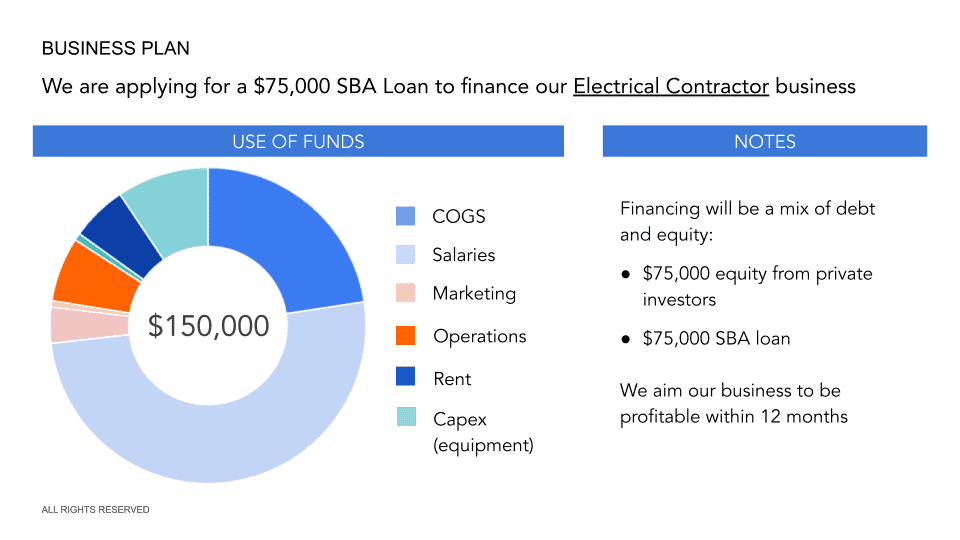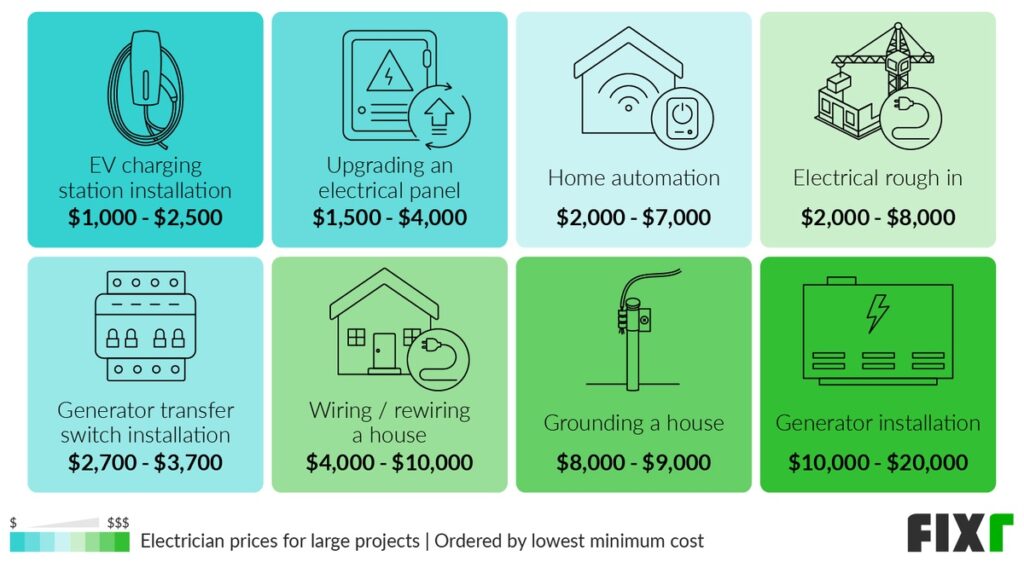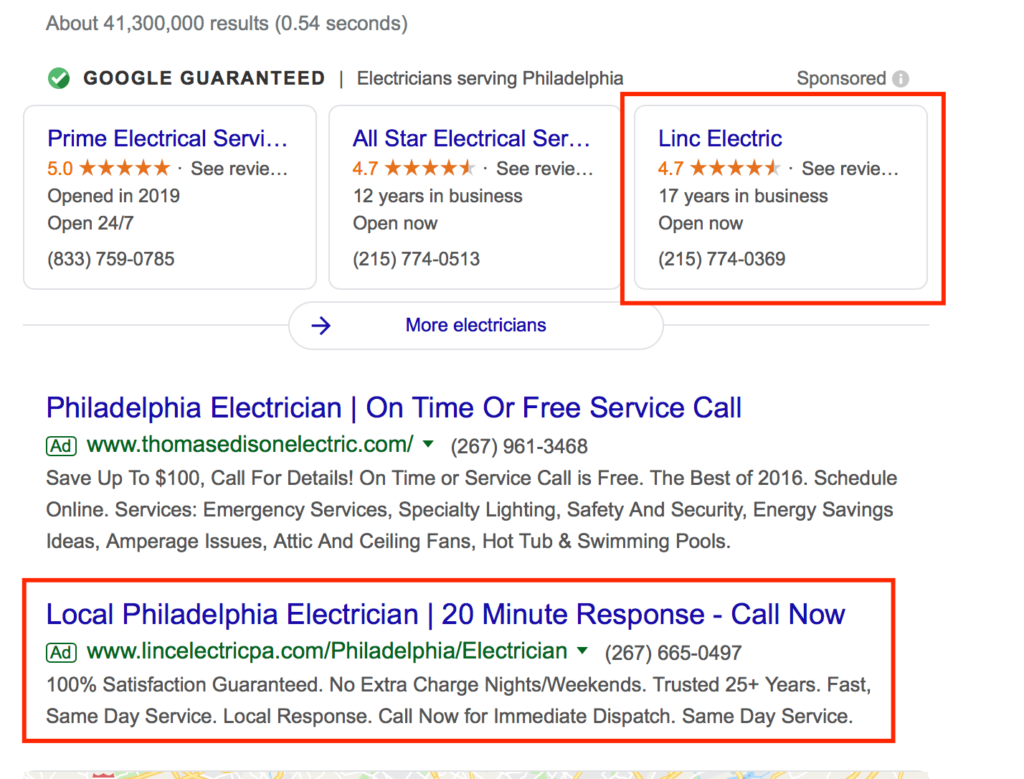How to Write a Business Plan for a Electrical Contractor

Whether you’re looking to raise funding from private investors or to get a loan from a bank (like a SBA loan) for your electrical contractor company, you will need to prepare a solid business plan.
In this article we go through, step-by-step, all the different sections you need in the business plan of your electrical contractor business. Use this template to create a complete, clear and solid business plan that get you funded.
For more information on electrical contractors, make sure to read our guide below: How to Start an Electrical Business in 10 Steps
1. Electrical Business Executive Summary
The executive summary of a business plan gives a sneak peek of the information about your business plan to lenders and/or investors.
If the information you provide here is not concise, informative, and scannable, potential lenders and investors will lose interest.
Though the executive summary is the first and the most important section, it should normally be the last section you write because it will have the summary of different sections included in the entire plan.
Why do you need a business plan for an electrical business?
The purpose of a business plan is to secure funding through one of the following channels:
- Obtain bank financing or secure a loan from other lenders (such as a SBA loan)
- Obtain private investments from investment funds, angel investors, etc.
- Obtain a public or a private grant
How to write an executive summary for an electrical business?
Provide a precise and high-level summary of every section that you have included in the business plan of your electrical business. The information and the data you include in this segment should grab the attention of potential investors and lenders immediately.
Also make sure that the executive summary doesn’t exceed 2 pages in total: it’s supposed to be a summary for investors and lenders who don’t have time to scroll through 40-50 pages, so keep it short and brief.
The executive summary usually consists of 5 major sub-sections:
- Business overview: start by introducing your proposed electrical contracting firm, where it is located, the services you will offer, and the pricing strategy you want to implement. Mention what sets you apart from other businesses. For example, you may be a master electrician with a decade of experience in designing electrical systems.
- Market analysis: summarise the market where you will operate and provide a brief about your target market, target audience, spending capability, etc. Also give certain data points about the electrical contractor business industry in the area where you want to operate (size and growth), as well as an overview of the main competitors, etc.
- People: introduce your electrical business’ management and employee structure. Provide a brief (no more than a couple of sentences each) of the knowledge and experience of the team. Also, mention how the company will be structured (management roles and reporting lines)
- Financial plan: how much profit and revenue do you expect in the next 5 years? When will you reach the break-even point and start making profits? You can include here a chart with your key financials (revenue, gross profit, net profit)
- Funding ask: what loan/investment/grant are you seeking? How much do you need? How long will this last?

2. Electrical Business Overview
In this segment of the business plan, you will provide details about your proposed electrical contracting firm.
You must answer here some important questions that potential investors and lenders often ask about your business and operations. Here are some examples of questions you must answer:
- What is the rationale behind your opening an electrical contractor business today?
- In which location will you operate and why?
- What type of services will you offer?
- Are there specific types of services and/or industries that you specialize in?
- What will be your pricing strategy and why?
- What will be the legal structure of your company?
a) History of the Project
Any business overview must start with explaining the history of the project. There are 2 components here:
- Passion & experience of the business owner
- Rationale behind starting an electrical business today
Passion & experience
You must display your passion while at the same time, you must also showcase your experience. For instance, you may have 10 years of journeyman experience, or you may be a master electrician with the ability to design ground-breaking electrical systems.
Rationale
Is there a certain problem (or perhaps, a set of problems) that your electrical contracting firm will try to solve when it comes into existence?
For example, there may be a steady increase in demand for commercial electrical contracting firms but there are only a few unorganized service providers incapable of efficiently handling commercial contracts.
The rationale behind your project must be backed up by a thorough analysis of the industry in the area where you plan to open your electrical contractor business. This is what we will cover under Market Overview further below.

b) Business Model
This section of the Business Overview should explain the model you want to adopt for your electrical contractor business. For example:
- Which target audience segment you will focus on and why?
- Is there enough demand for that segment in your focus area?
- What type of services you will offer?
What are the different types of electrical contractor companies?
You may choose one of the following:
- Residential Electrical Contractors: They usually collaborate with homeowners to design or install electrical systems
- Commercial Electrical Contractors: They usually focus on commercial and outdoor spaces like malls, shops, college campuses, gardens, parks, etc.
- Industrial Electrical Contractors: They usually focus on larger products like industrial manufacturing areas, warehouses, etc.
No matter what you select, you must ensure that there is enough demand for the type of electrical contracting firm you want to open and the range of services you will offer.
c) Services
The services you offer will depend on the type of customers you will serve and also on the skills you have. Provide a quick list of the major services that you will offer. Some services may include things like:
- Exterior and interior lighting
- Installation of safety systems & electronic appliances
- Electrical wiring and transmission line installation
- Repairs & upgrades, etc.

d) Pricing Strategy
Strategy
This is where you will provide an overview of your pricing strategy. For instance, you may charge higher than your competitors because you may have a team of highly experienced electricians and also because you use high-quality wires and other materials than your competitors.
Similarly, you may decide to charge lower than your competitors because of the bulk purchase of products like wires, switches, etc., which allows you to bring down the cost of your services.
Whatever the case is, explain your pricing strategy and the logic behind it.
Pricing table
While it may not be possible to provide a proper pricing table for all services that you will offer, it is still a great idea to provide a table that gives an overview of your pricing structure.
Providing individual pricing for all services may not be possible, however, you may provide a range. For example:
- Smart systems installation: $75 to $150 per hour (depending on the system and area)
- Repair and upgrades: $80 to $120 per hour
However, don’t go into extreme details because potential investors are not interested in the nitty-gritty of your pricing. They just need the big picture to assess the profitability, because they will tie your pricing strategy with your financial projections later on.

e) Company Legal Structure
Finally, your business overview section should specify what type of business structure you want. Is this a corporation or a partnership (LLC)? Who are the investors? How much equity percentage do they own? Is there a Board of Directors? If so, whom? Do they have experience in the industry?
3. Electrical Business Market Overview
A complete understanding of the market where you want to operate is important for the success of your business. That’s also something you must showcase in your business plan.
For example, if there is a high demand for residential and commercial electrical contractors but you want to focus on industrial customers despite a very small market size, it may not be a great business decision.
Therefore, you must cover here 3 important areas:
- Market size & growth: how big is the electrical contractor business industry in your area? What is its growth rate (or decline rate) and what are the factors contributing to its growth or decline?
- Competition overview: how many competitors are there? What type of customers do they serve? What type of projects do they specialize in? How do they compare vs. your business? How can you differentiate yourself from them?
- Customer analysis: who is your target audience? How frequently do they require electrical contractor services? What is their yearly spending on electrical contractor services?
a) Electrical Contractor Industry Size & Growth
How big is the electrical contractor industry in the US?
In 2021 there were over 70,000 electrical contracting firms in the US employing about 650,000 electrical workers.
As per the National Electrical Contractors Association (NECA) the industry is worth $202 billion: that’s an average annual turnover of $2,800,000 per company!
Also, the vast majority of electrical contractors are small businesses: over 80% of all businesses had less than 10 employees.

How big is the electrical contractor industry in your area?
After getting a clear picture of the electrical contractor business industry in the US as a whole, narrow down to your location. It’s very likely that you won’t find the number anywhere (at least not for free).
In that case, you can use our guide to estimate the TAM, SAM, and SOM for your business. Here is an example of how to do it:
We already know that the average annual turnover for electrical contracting firms in the US is $2.8 million. Therefore, if the area where you will operate (a city for example) has a total of 30 electrical contractors, the electrical service industry in the area is worth approximately $84 million.

What’s the market growth of the electrical contractor industry in your area?
Next on our list is market growth: is the industry growing or declining in your area?
US market growth can be a great addition to your business plan, yet it doesn’t necessarily help to assess the industry in your area of service. For example, the industry might be growing in the US, but declining in your region for a number of reasons (for example, the large commercial market may be contracting because businesses are shutting down due to losses, resulting in the closure of electrical contractor businesses that focused on the commercial market).
As you likely won’t find this information online, you can instead rely on the number of electrical contractor businesses in the location to calculate the average growth rate of the industry in your area.
For example, if the region had only 27 electrical contractor businesses in 2019 and 30 in 2021, you can assume that the average annual growth rate of the electrical contractor businesses industry in the area is around 5-6%.
b) Competition Overview
Studying your competitors’ business models is vital. You need to understand what makes them successful or why they fail. A clear understanding of their business model, the products they sell, their marketing strategies, etc., will allow you to provide a better service.
If your competitors are offering nearly the same services, then what is their market share and how do they market their products & services to attract new customers?
It is always a good idea to do some research (if necessary, you may consider physically visiting your competitors without revealing your business intentions) and create a comparative table summarizing their service offerings, marketing strategies, target audience, etc.
Here is a sample table that you can use:
| Competitor #1 | Competitor #2 | Competitor #3 | |
|---|---|---|---|
| Location | xx | xx | xx |
| Business model | Industrial electricians | Commercial electricians | Smart solutions installation |
| Services offered | xx | xx | xx |
| Pricing | xx | xx | xx |
| Staff | 40 | 8 | 12 |
Electrical Business SWOT Analysis
SWOT stands for Strength, Weakness, Opportunities, and Threats. This analysis will help lenders and investors better understand how you compare vs. competitors as well as the overall risk and reward profile of your business.
Here is a sample that you can use as a reference:
- Strengths: 12 years of experience as a master electrician in a popular electrical contractor company
- Weaknesses: Startup cost, no initial brand reputation
- Opportunities:
- Increased construction of residential apartments due to demand spike in rental housing and builders are looking for skilled electricians for wiring everything (backup with data for population and real estate boom)
- Growth in retail stores and malls (because of population influx), which in turn has increased the demand for electricians for installation and maintenance (provide data)
- Increased commercial warehouse construction because of increased regional distribution centers by e-commerce retailers that require electrical installations (provide data and explain why there is an increase in commercial warehouse construction – for example, increased demand and hence imports of cheaper products)
- Threats: Big brands like Helix Electric, Bergelectric, & Cupertino Electric, Inc. are all eyeing the growing market

c) Customer Analysis
Finally, we need to look at your customers.
However, the first thing you must do is clearly define the target audience. For instance, you may serve individual households, commercial establishments, or even industrial establishments.
Some important points that you must include in your customer analysis include:
- How much do your target customers spend on electrical services per year?
- How frequently do they need electrical contractors?
- What type of electrical services do they usually require (fresh installations, inspections, repairs, etc.)?
- What type of electrical contractors do they usually hire (big brands, small contractors, individual electricians, etc.)?
- What do they dislike about the existing electrical contractors in the area (for example, slow response time)?

4. Sales & Marketing Strategy
This is the section where you outline your customer acquisition strategy. Try to answer here the following questions:
- What is your Unique Selling Proposition (USP)?
- What are the different marketing strategies you will use?
- How do you intend to track the success of your marketing strategy?
- What is your CAC or customer acquisition cost?
- What is your marketing budget?
- What introductory promos and offers do you intend to provide for attracting new customers?
- What marketing channels do electrical businesses use?
What marketing strategies do electrical contractors use?
A few marketing channels that electrical businesses typically use are:
- Signages, vehicle branding
- PPC ads (Google local services ads)
- Social media platforms
- Flyers & pamphlets
- Word of mouth, recommendations
It is not necessary to use all channels. Instead, you can start by focusing on a few of them, and include other marketing strategies later.

What is your Unique Selling Proposition (USP)?
In other words, how do you differentiate yourself vs. competitors? This is very important as you might need to win customers from competitors.
A few examples of USPs are:
- Response Time: you may respond within 30 minutes (whatever you can commit to), which is faster than any competitor
- Emergencies: you may have years of experience dealing with electrical emergencies that can potentially cause immense damage to life and property
- Free inspection: you may offer one free inspection of wiring and other installations once every quarter
Your USP will depend on your business model, competitor analysis, and target audience. Whatever your USP be, it should be clear and appealing to your target audience.
5. Management & People
You must address two things here:
- The management team and their experience
- The organization structure: different team members and who reports to whom?
Management
Small businesses often fail because of managerial weaknesses. Thus, having a strong management team is vital. Highlight the experience and education of senior managers that you intend to hire to oversee your electrical business.
Describe their duties, responsibilities, and roles. Also, highlight their previous experience and explain how they succeeded in their previous roles.
It is also important that you explain how their experiences and qualifications help you in implementing the electrical business you are proposing. If they have specialized training and experience (master electrician or journeyman electrician for 8 years in a reputed electrical contractor firm), add that information.
Organization Structure
Even if you haven’t already hired electricians, trainees, managers, drivers, accountants, and other relevant staff members, you must provide a flowchart of the organizational structure defining hierarchy and reporting lines.

6. Financial Plan
The financial plan is perhaps, with the executive summary, the most important section of any business plan for an electrical contractor company.
Indeed, a solid financial plan tells lenders that your business is viable and can repay the loan you need from them. If you’re looking to raise equity from private investors, a solid financial plan will prove them your electrical contractor company is an attractive investment.
There should be 2 sections to your financial plan section:
- The startup costs of your company
- The 5-year financial projections
a) Startup Costs
Before we expand on 5-year financial projections in the following section, it’s always best practice to start with listing the startup costs of your project.
For an electrical contractor company, startup costs are all the expenses you incur before you start making sales. These expenses typically are limited especially for small businesses and include:
- The lease deposit (if you rent an office and/or warehouse for your equipment)
- Vehicles
- Electrical equipment, tools, etc.
- License & permits, business insurance, etc.
Of course, the startup costs depend on a number of factors, like the size of your business (employees), the services you plan to offer (which will dictate what equipment you may need), etc.
b) Financial Projections
In addition to startup costs, you will also need to build a solid 5-year financial model in the business plan of your electrical company.
Note that your financial projections should be built using a spreadsheet (e.g. Excel or Google Sheets) and presented in the form of tables and charts in your business plan.
As usual, keep it concise here and save details (for example detailed financial statements, financial metrics, key assumptions used for the projections) for the appendix instead.
Your financial projections should answer at least the following questions:
- How much revenue do you expect to generate over the next 5 years?
- When do you expect to break even?
- How much cash will you burn until you get there?
- What’s the impact of a change in pricing (say 10%) on your margins?
- What is your average customer acquisition cost?
You should include here your 3 financial statements (income statement, balance sheet and cash flow statement). This means you must forecast:
- The number of contracts (customers) over time ;
- Your expected revenue ;
- Operating costs to run the business ;
- Capex (cost to buy the equipment and vehicles, etc.)
When projecting your financials, make sure to sensitize sales volume (customers), pricing as well as the expenses (inventory, salaries, etc.). Indeed, a small change in these assumptions may have a significant impact on your revenues, and most importantly, your profits.

7. Use of Funds
This is the last section of the business plan of your electrical contractor company. Now that we have explained what your business model is, what type of services you offer, how you get customers, etc., this section must now answer the following questions:
- How much funding do you need?
- What financial instrument(s) do you need: is this equity or debt, or even a free-money public grant?
- How long will this funding last?
- Where else does the money come from? If you apply for a SBA loan for example, where does the other part of the investment come from (your own capital, private investors?)
If you raise debt:
- What percentage of the total funding the loan represents?
- What is the corresponding Debt Service Coverage Ratio?
If you raise equity
- What percentage ownership are you selling as part of this funding round?
- What is the corresponding valuation of your business?
Use of Funds
Any business plan for an electrical contractor company should include a clear use of funds section. This is where you explain how the money will be spent.
Will you spend most of the loan / investment in paying your employees’ salaries and the COGS (inventory)? Or will it cover mostly the cost for acquiring the equipment and machines?
For the use of funds, we also recommend using a pie chart like the one we have in our financial model template where we outline the main expenses categories as shown below.


